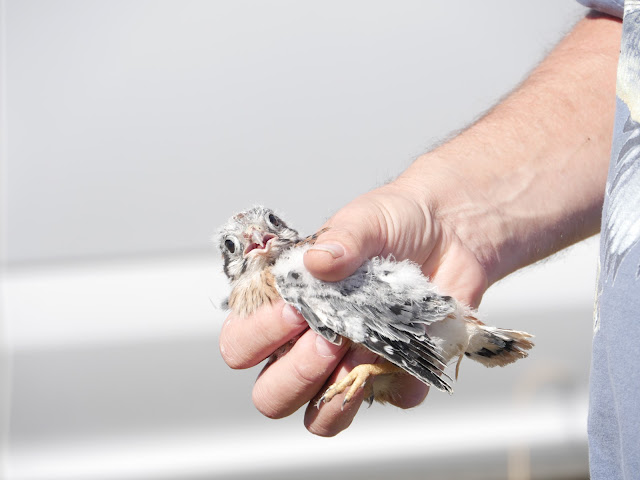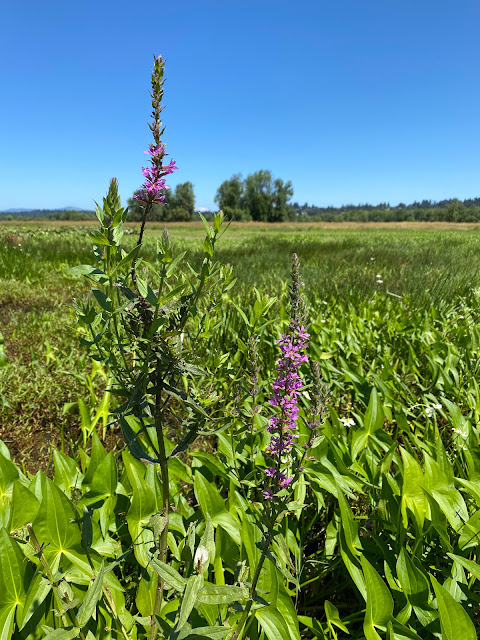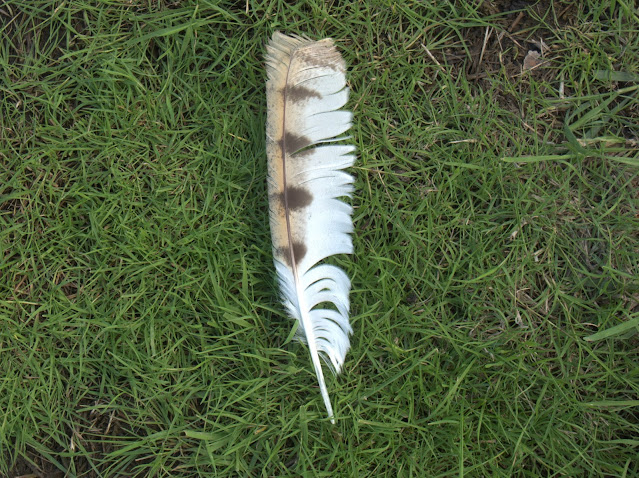While American Kestrels are the smallest of the falcons in North America, I would argue that they are among the fiercest of the predatory birds. Dr. Brad Tripp and his students, from the Department of Natural Sciences and Health at Warner Pacific College in Portland, have been collecting nest box data on American Kestrels at the Ridgefield National Wildlife Refuge for 17 years, and have banded over 200 kestrels. While data collection is still ongoing, it is evident from Tripp's research that American Kestrel populations have been steadily declining at Ridgefield since 2005. One of the main hypotheses for this decline is that there seems to be an increase in nest cavity competition from European Starlings. Dr. Tripp's article, published with Ben Durham, dives into an in-depth evaluation of the factors impacting kestrel population decline here at Ridgefield NWR. Click here to view the article.
Back towards the tail end of June, Dr. Tripp came out to teach us how to band baby American Kestrels. The FWS Biotechs and I got to participate in this amazing opportunity, and we learned about the research that Dr. Tripp and his students have been conducting for the last two decades. Below are a series photos that detail the data collection that Tripp conducts on the baby kestrels each year.
 |
Here is an image of Dr. Tripp grasping an adorable kestrel chick while he introduced us to his data collection methods. Kestrel chicks become fully grown at about 20 days after hatching, and will fledge from the nest at about 27-32 days of age.
|
 |
Tripp and the student he brought along to help with the process collected the chicks out of a nest box that was near the Bachelor Island shop. American Kestrels differ from many other North American falcons because they prefer to nest in cavities, instead of cliff ledges. Kestrels do not construct their own nest cavities however, and will utilize a variety of cavity types including woodpecker holes, squirrel nests, man-made nest boxes, or other similar structures to lay their eggs in. |
 |
There was a total of three kestrel chicks in this specific nest box. One each for Vee, Justine, and I to band.
|
 |
During the banding process, Tripp also collects a variety of measurements from each of the birds in the nest box. Here, Tripp was explaining to us how he measures the tail feathers of the chicks.
|
 |
Tail feathers being measured with a ruler. |
Tripp also gathered the leg length of each chick.
Here, you can see how Tripp gathered the weight of each chick. He would gently wrap them in a bandana, and then suspend them from a scale. The entire process took about 15 to 20 seconds.
 |
Justine, FWS Biotech, placing a band around the leg of a kestrel chick with Tripp's guidance. |
Vee's turn to band a kestrel chick.
Participating in this banding lesson was such an amazing opportunity, and I learned so much about these resilient little raptors. One amazing fact that Tripp brought up during this lesson was that since last year, kestrel populations at Ridgefield have actually increased slightly in comparison to previous years. While there is not enough data to say whether or not this is a fluke in the trend, it was still exciting to hear this good news. According to Tripp, one potential factor that could have influenced this small increase may be due to climate change. Warming temperatures may have influenced the timing at which the kestrels decided to lay their eggs, meaning that they could have potentially gotten to nesting cavities earlier than in previous years - giving them a chance to outcompete other cavity nesters. Prey such as insects and rodents may also be thriving in warmer conditions which would allow for the kestrels to have more nutrition during their nesting intervals. The closures of the auto tour route last year due to the pandemic and lack of travel may have also contributed to the higher success rate of the kestrels. While none of these hypotheses are definitive yet, it will be interesting to see how these birds continue to adapt to a rapidly changing environment.











Comments
Post a Comment